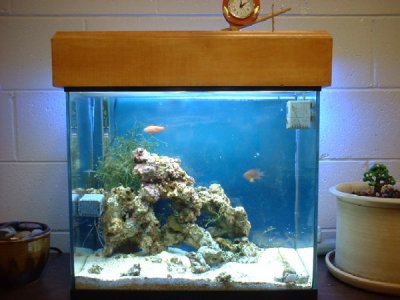reefburnaby
New member
Hi,
VHOs on an electonic ballast (4xF32T8s)
Yes, you can drive one VHO with this setup...although, the lamp will only be as bright as a Icecap (or roughly). Regular VHO ballasts (the real ANSI standard ones that most people can't buy), are brighter. It is possible to hook the VHOs in series and light them both.
How it works is that the 4x configuration converts this ballast in to a 600mA to 800mA lamp current ballast. Lamp current is the current flowing through the actual fluorescent tube. Normal T8s need about 235mA of lamp current. Normal VHOs need 1600mA of lamp current. Icecap delivers around 600mA to 800mA of lamp current to their lamps -- this overdrives T8s/T12s and underdrives VHOs. By underdriving VHOs, they can improve the lifetime of the lamps (from 6 months to more than a year).
The power drawn might be higher than the rated wattage (as stated on the box), but they tend to put safety factors around those numbers. So, if you wish (knowing the risks), you can use them to drive two VHOs at 65W to 80W a piece (I didn't measure the actual power yet). The limiting factor with electronic ballasts is the heat that they produce...higher heat...less power it can handle before blowing up. So, if you can keep the ballast cool (with a fan or in a well ventalated area) than you should be fine. These ballasts are designed to work in crawl spaces with no ventalation at 70 to 85 degrees Celcius (~190 F).
So, if you have an old set of VHO tubes, you can give them a try. Keep in mind that VHO tubes may only last 6 to 10 months...unlike Icecap ones. This is mainly due to the fact that our ballasts do not have the fancy starting mechanism -- even through the reduced lamp current may increase lifetime.
Another alternative (a better one) is to use Workhorse 7 or 6 ballasts.
Finding those elusive T8s ?
Grainger should carry these lamps and they have outlets all around the country. Last time I looked, they sold them for $2.75 USD. 6500K is commonly referred in the lighting community as daylight. Cool = 4000K and warm = 3200K.
There should be other places that carry them....mainly light bulb distributors. Companies that sell lamps from Phillips, GE or Sylvania should sell or be able to get them for you.
Local contractors should be able to tell you where they buy their lighting stuff.
Hope that helps.
- Victor.
VHOs on an electonic ballast (4xF32T8s)
Yes, you can drive one VHO with this setup...although, the lamp will only be as bright as a Icecap (or roughly). Regular VHO ballasts (the real ANSI standard ones that most people can't buy), are brighter. It is possible to hook the VHOs in series and light them both.
How it works is that the 4x configuration converts this ballast in to a 600mA to 800mA lamp current ballast. Lamp current is the current flowing through the actual fluorescent tube. Normal T8s need about 235mA of lamp current. Normal VHOs need 1600mA of lamp current. Icecap delivers around 600mA to 800mA of lamp current to their lamps -- this overdrives T8s/T12s and underdrives VHOs. By underdriving VHOs, they can improve the lifetime of the lamps (from 6 months to more than a year).
The power drawn might be higher than the rated wattage (as stated on the box), but they tend to put safety factors around those numbers. So, if you wish (knowing the risks), you can use them to drive two VHOs at 65W to 80W a piece (I didn't measure the actual power yet). The limiting factor with electronic ballasts is the heat that they produce...higher heat...less power it can handle before blowing up. So, if you can keep the ballast cool (with a fan or in a well ventalated area) than you should be fine. These ballasts are designed to work in crawl spaces with no ventalation at 70 to 85 degrees Celcius (~190 F).
So, if you have an old set of VHO tubes, you can give them a try. Keep in mind that VHO tubes may only last 6 to 10 months...unlike Icecap ones. This is mainly due to the fact that our ballasts do not have the fancy starting mechanism -- even through the reduced lamp current may increase lifetime.
Another alternative (a better one) is to use Workhorse 7 or 6 ballasts.
Finding those elusive T8s ?
Grainger should carry these lamps and they have outlets all around the country. Last time I looked, they sold them for $2.75 USD. 6500K is commonly referred in the lighting community as daylight. Cool = 4000K and warm = 3200K.
There should be other places that carry them....mainly light bulb distributors. Companies that sell lamps from Phillips, GE or Sylvania should sell or be able to get them for you.
Local contractors should be able to tell you where they buy their lighting stuff.
Hope that helps.
- Victor.

